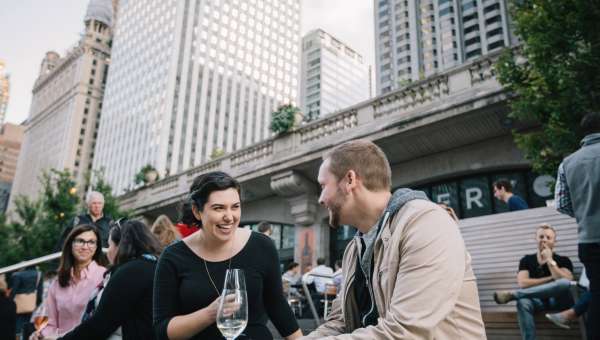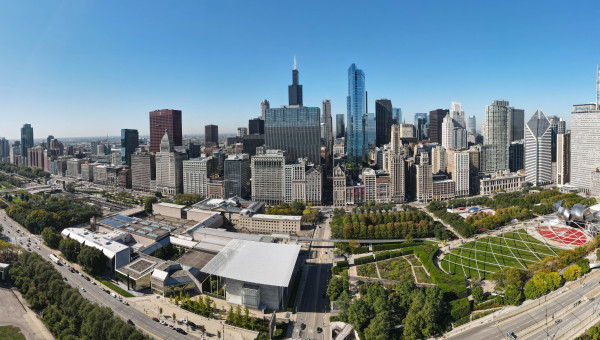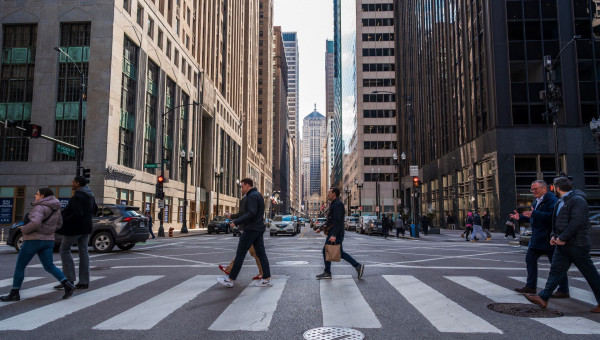Posted 21 months ago in the loop, everyone's neighborhood, community, chicago, Trending
5 MIN READ –Any true Chicagoan, or well-informed visitor, knows that to fully experience the city of Chicago, you can’t skip exploring the Loop, Chicago’s official downtown area, also known as "Everyone's Neighborhood." The moniker recognizes that ‘home’ isn’t just the place where Chicagoans sleep, but the world-class restaurants, shops, offices, schools, theaters, attractions, parks and streets they experience together.
In Chicago, all trains lead to The Loop. This means for just a $2.50 CTA ride, anyone in the city can readily access The Loop, whether for school, work, or leisure.
The Loop remains the largest central business district in the United States, outside of Midtown Manhattan, serving as a critical workplace for hundreds of thousands of residents from every single neighborhood in the city of Chicago.
The neighborhood also welcomes millions of global visitors each year, and as part of the fastest growing residential downtown in the United States, people don’t just work and play here, many also call the Loop home.

Visitors, workers and residents in the Loop also share the neighborhood with thousands of high school and college students attending school, including Innovations High School, DePaul University, and Columbia College Chicago, making it a welcoming environment to academically learn and grow.
In a sprawling major city like Chicago with millions of residents, many Chicagoans spend most of their time in a handful of neighborhoods close to their homes, without ever venturing out across all 77 unique neighborhoods and over 100 community areas. The Loop serves as an exception to this trend and a central meeting place. Chicagoans from all over the city know and love the Loop, often more than any other area outside their own community neighborhoods.
For a city, like many others, still facing significant racial and economic segregation, this makes the Loop a critical gathering place and shared cultural confluence for the entire city. Chicago’s most iconic celebrations and protests occur in the Loop, converging people from all walks of life.

The vibrancy of the Loop can’t be understated. From various restaurants and shops, to countless cultural attractions and major institutions– not to mention the iconic Cloud Gate sculpture a.k.a. “The Bean” and the captivating Riverwalk– it’s no wonder tourists and Chicagoans alike flock to The Loop to take in the vibrant wonderment of the neighborhood.
Still, like most other major central business districts in the U.S., the Loop faces the reality of inequitable distribution between wealth and power. And the true vision for Everyone’s Neighborhood includes a reality in which the great diversity of people from all backgrounds and walks of life who inhabit the Loop each day, also share more equal access to the significant wealth and power of the central business district. That remains an important goal of Everyone’s Neighborhood.

Ensuring Everyone’s Neighborhood
Chicago Loop Alliance (CLA), who introduced the moniker in 2020, understands the importance of maintaining this inclusive and vibrant atmosphere. In 2023, Chicago Loop Alliance unveiled a five-year strategic organizational plan which called out four priority areas – Building Confidence in the Loop; Increasing Chicago Loop Alliance’s (CLA) Profile and Impact; Ensuring Everyone’s Neighborhood; and Creating a Complete Urban District.
To ensure The Loop is "Everyone's Neighborhood" and attract talent and investment in the Loop, CLA must care for Chicago’s diverse communities, requiring meaningful working partnerships with organizations that represent the interests of traditionally underrepresented groups. This means delivering clearly defined inclusive programs both internal to the CLA organization and external to Loop stakeholders. Catalytic actions include:
- Intentionally increase individuals from underrepresented communities within CLA’s membership, staff, board of directors, and event participants with a goal to represent Chicago’s city-wide racial demographics
- Accelerate CLA partnerships in events like Hospitality Hires and Downtown Days that are designed to provide more opportunities for everyone to participate in the Loop
- Advocate for universal accessibility in all public realm projects in the Loop
- Tactically address climate change effects on State Street and the Loop, which also disproportionately affect disadvantaged communities
All in all, The Loop stands as a vibrant hub of diversity, opportunity, and cultural richness, inviting residents, workers, students, and visitors alike to immerse themselves in its dynamic atmosphere and endless array of experiences.
Everyone is welcome in Everyone’s Neighborhood—the Loop. Plan your next trip to the Chicago Loop here.




